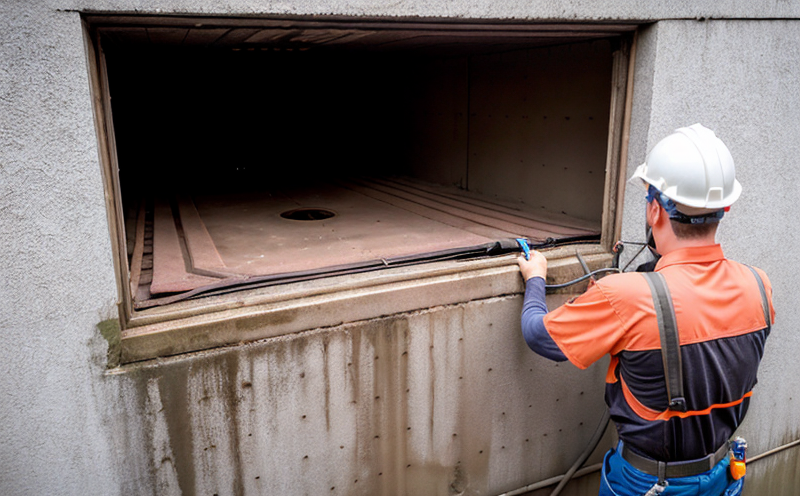Ventilation shaft inspection
In the realm of construction and building inspection, ventilation shafts are critical components that ensure optimal air quality, reduce energy consumption, and enhance occupant comfort. These vertical or horizontal conduits channel fresh air into buildings while expelling stale air, smoke, and other pollutants. Given their strategic importance, regular inspections of ventilation shafts are essential to maintain compliance with local building codes and international standards.
The primary goal of a ventilation shaft inspection is not only to ensure structural integrity but also to identify potential hazards such as obstructions, corrosion, or excessive buildup of debris that could impede airflow. This service is particularly crucial in high-rise buildings where the consequences of poor maintenance can be severe. For instance, inadequate ventilation systems have been linked to respiratory illnesses and other health concerns among building occupants.
According to ISO 13782:2015, the performance characteristics of HVAC (Heating, Ventilation, and Air Conditioning) systems are directly influenced by the quality of their ventilation shafts. Therefore, regular inspections can help in meeting these stringent standards, ensuring that buildings meet not only regulatory requirements but also the expectations set by sustainability goals.
Using advanced inspection techniques such as video endoscopy and laser scanning allows inspectors to assess conditions within the shafts accurately. These methods provide detailed images and measurements that are indispensable for identifying even the smallest issues that could lead to significant problems if left unattended. The data collected from these inspections can be used to generate comprehensive reports which serve as a roadmap for corrective actions.
A key aspect of ventilation shaft inspection involves analyzing the type and amount of particulate matter present in the air flow. This analysis helps determine whether the system is effectively filtering out contaminants, thereby maintaining indoor air quality standards. Additionally, moisture levels within the shafts play a crucial role; excessive humidity can lead to mold growth, which poses serious health risks.
Another important factor during inspections is checking for any signs of corrosion or damage from external elements like rainwater penetration. Corrosion not only weakens structural integrity but also increases maintenance costs over time. By addressing these issues early on through thorough inspections and timely repairs, building owners can extend the lifespan of their facilities significantly.
The findings from ventilation shaft inspections play a vital role in ensuring that buildings comply with local regulations regarding environmental impact assessment reports. Compliance officers often rely on such data to make informed decisions about necessary upgrades or modifications aimed at improving overall sustainability practices within the organization.
Benefits
Regular ventilation shaft inspections offer numerous benefits beyond just meeting compliance requirements. Firstly, they help prevent costly repairs by catching problems early when they are easier—and less expensive—to fix. Secondly, these inspections contribute significantly to enhancing indoor air quality, thus promoting healthier living and working environments for everyone involved.
From an operational perspective, ensuring proper ventilation also contributes positively towards reducing energy costs associated with HVAC systems. By keeping the shafts clear of blockages or obstructions, more efficient airflow can be maintained, leading to lower energy consumption levels over time.
In terms of safety, conducting routine inspections helps eliminate hazards such as fire risks due to restricted airflow or accumulation of flammable materials within the shafts. This proactive approach ensures that buildings remain safe places for both staff and visitors alike.
International Acceptance and Recognition
Ventilation shaft inspections are widely recognized across various international standards, including ISO 13782:2015 which emphasizes the importance of proper HVAC system performance. Compliance with these guidelines is crucial for maintaining high-quality air conditions within buildings.
Moreover, organizations like ASHRAE (American Society of Heating, Refrigerating and Air-Conditioning Engineers) provide recommendations on best practices for ventilating shafts to ensure they operate efficiently without causing any disruption elsewhere in the building. Adherence to such standards not only enhances reputation but also attracts potential clients who value reliability and safety.
International acceptance extends beyond just theoretical acknowledgment; it translates into practical applications where countries around the world implement similar measures based on these principles. This widespread adoption underscores the significance of regular ventilation shaft inspections in maintaining healthy indoor environments globally.
Use Cases and Application Examples
| Use Case | Description |
|---|---|
| Data Center Ventilation | Ventilation shafts in data centers are inspected to ensure efficient cooling of servers and other electronic equipment. Any blockages or obstructions can lead to overheating, which might damage sensitive hardware. |
| Office Buildings | In office buildings, regular inspections help maintain optimal air quality levels by preventing the buildup of harmful pollutants like carbon dioxide and volatile organic compounds (VOCs). |
| Schools and Hospitals | Ventilation shafts in educational institutions and healthcare facilities are inspected to guarantee safe and healthy environments for students, teachers, patients, and staff. |
| High-Rise Apartments | In multi-story apartment complexes, ventilation shaft inspections ensure that each unit receives adequate fresh air while preventing odors from one floor spilling into another. |
| Hospitals | Inspections in hospital settings focus on ensuring strict adherence to infection control protocols by maintaining clean and sterile air flow through all areas of the facility. |
| Data Centers | Ventilation shafts are inspected regularly at data centers to ensure efficient cooling of servers and other electronic equipment, preventing potential overheating issues that could lead to hardware failures. |





